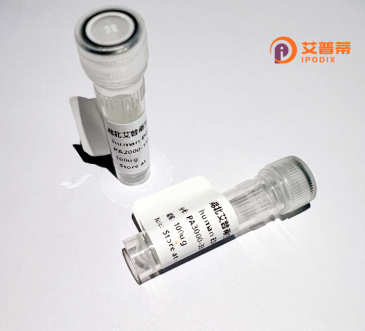
| 纯度 | >90%SDS-PAGE. |
| 种属 | Human |
| 靶点 | PC4 |
| Uniprot No | O75475 |
| 内毒素 | < 0.01EU/μg |
| 表达宿主 | E.coli |
| 表达区间 | 1-530 aa |
| 活性数据 | MTRDFKPGDLIFAKMKGYPHWPARVDEVPDGAVKPPTNKLPIFFFGTHETAFLGPKDIFPYSENKEKYGKPNKRKGFNEGLWEIDNNPKVKFSSQQAATKQSNASSDVEVEEKETSVSKEDTDHEEKASNEDVTKAVDITTPKAARRGRKRKAEKQVETEEAGVVTTATASVNLKVSPKRGRPAATEVKIPKPRGRPKMVKQPCPSESDIITEEDKSKKKGQEEKQPKKQPKKDEEGQKEEDKPRKEPDKKEGKKEVESKRKNLAKTGVTSTSDSEEEGDDQEGEKKRKGGRNFQTAHRRNMLKGQHEKEAADRKRKQEEQMETEQQNKDEGKKPEVKKVEKKRETSMDSRLQRIHAEIKNSLKIDNLDVNRCIEALDELASLQVTMQQAQKHTEMITTLKKIRRFKVSQVIMEKSTMLYNKFKNMFLVGEGDSVITQVLNKSLAEQRQHEEANKTKDQGKKGPNKKLEKEQTGSKTLNGGSDAQDGNQPQHNGESNEDSKDNHEASTKKKPSSEERETEISLKDSTLDN |
| 分子量 | 76.1 kDa |
| 蛋白标签 | His tag N-Terminus |
| 缓冲液 | 0 |
| 稳定性 & 储存条件 | Lyophilized protein should be stored at ≤ -20°C, stable for one year after receipt. Reconstituted protein solution can be stored at 2-8°C for 2-7 days. Aliquots of reconstituted samples are stable at ≤ -20°C for 3 months. |
| 复溶 | Always centrifuge tubes before opening.Do not mix by vortex or pipetting. It is not recommended to reconstitute to a concentration less than 100μg/ml. Dissolve the lyophilized protein in distilled water. Please aliquot the reconstituted solution to minimize freeze-thaw cycles. |
以下是关于重组人PC4蛋白的参考文献概览:
1. **文献名称**: **Human Positive Cofactor 4 (PC4) Promotes Transcriptional Activation through Direct Interactions with Mediator and RNA Polymerase II**
**作者**: K. Kaiser 等
**摘要**: 该研究揭示了重组人PC4通过与中介复合体和RNA聚合酶II直接相互作用,增强基因特异性转录激活的分子机制,证实其作为转录共激活因子的功能。
2. **文献名称**: **Structural Basis for PC4-mediated DNA Unwrapping and Recruitment in Transcription Regulation**
**作者**: S. Banerjee 等
**摘要**: 通过冷冻电镜技术解析了PC4蛋白结合单链DNA的结构,阐明其通过DNA解旋和招募染色质修饰因子调控转录起始的过程。
3. **文献名称**: **PC4 Links DNA Damage Responses to Chromatin Remodeling in p53-Dependent Apoptosis**
**作者**: Y. Li 等
**摘要**: 研究发现重组PC4在DNA损伤条件下激活p53依赖的凋亡通路,通过促进染色质重塑因子的募集响应基因组稳定性信号。
4. **文献名称**: **Recombinant PC4 Enhances CRISPR-Cas9 Genome Editing Efficiency by Stabilizing Single-Stranded DNA**
**作者**: M. Tanaka 等
**摘要**: 该文证明重组PC4通过稳定CRISPR-Cas9系统中的单链DNA结构,显著提高基因编辑效率和靶标特异性。
**Background of Recombinant Human PC4 Protein**
The human positive coactivator 4 (PC4), also known as SUB1 homolog or transcriptional coactivator PC4. is a multifunctional protein involved in key cellular processes such as transcription regulation, chromatin remodeling, and DNA repair. Structurally, PC4 contains a conserved N-terminal chromatin-binding domain, a central single-stranded DNA (ssDNA)-binding domain, and a C-terminal region mediating protein interactions.
As a transcriptional coactivator, PC4 enhances RNA polymerase II-dependent transcription by interacting with general transcription factors (e.g., TFIIA, TFIIH) and sequence-specific activators like p53. It facilitates transcription initiation and elongation by stabilizing preinitiation complexes and resolving G-quadruplex DNA structures. PC4 also participates in DNA damage response pathways, aiding in homologous recombination repair by binding to ssDNA at repair sites.
Recombinant PC4 protein, produced via bacterial or eukaryotic expression systems, retains these functional properties. It serves as a vital tool for studying transcription mechanisms, genome stability, and chromatin dynamics. Dysregulation of PC4 is linked to cancer and neurodegeneration, highlighting its therapeutic relevance. Additionally, PC4’s role in non-coding RNA regulation and viral replication further underscores its broad biological significance. Research continues to explore its dual roles as a transcriptional enhancer and genome guardian.
×